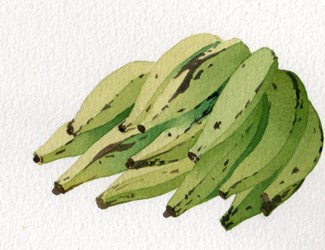
While the banana is high in sugar and either eaten raw or included as an ingredient in puddings, the plantain is starchy, lower on the glycemic index and richer in fibre, and effectively plays a savoury role on the culinary stage – although I have come across it as a fritter in Mexico, dipped into a sweet batter, deep or shallow fried and served at the end of a meal with a syrup poured over it (which is misleading known as “miel”, honey). It is larger than a banana, measuring on average 25 to 30 cm in length, and a bright pea green colour when unripe. As it matures, it slowly turns yellow, then deep gold, at which stage dark patches start to appear. By the time it is fully ripe, it is pretty much browny black all over, soft and considerably sweeter than in its younger days, with the original starch converted into sucrose. These different stages of maturity call for different cooking methods, from boiling, steaming, baking and mashing to frying, roasting and grilling.
While plantains appear in regional recipes throughout Mexico, they are most traditionally used in the cuisines of the tropical, southern and coastal states. In Veracruz, for instance, plantains are boiled in their skins until soft and the flesh pounded into a dough to be wrapped around a pungent filling – cheese or spicy meat perhaps - like a turnover. In Tabasco, the plantain may be sliced about 4 cm thick and fried, flattened to half its original size before being fried for a second time and seasoned with salt and chilli to make wonderfully crunchy, faintly sweet and spicy “tostones”. One of the simplest – and most delicious – uses for plantains is with plain rice, arroz con plátano macho, where slices of plantain are fried and spooned over the rice as a garnish and then served either as a course on its own or as an accompaniment. Plantains also show up traditionally in “picadillos” and casseroles of meat and other fruits, particularly with pork and beans or lentils, as well as the sweet, spicy “moles” of Puebla and Oaxaca – “mole coloradito” and “mancha manteles” are typical examples.
Plantains are widely available in most supermarkets, let alone Asian and Latin American shops, but they are usually green and unripe and require storing at room temperature for at least a week, if not longer, before they start to mature and turn yellow. Some forward planning and organisation is therefore usually required. They do, however, freeze well so it is worth buying two or three at a time; once ripe, ie deep gold with dark patches, peel them, roll tightly in plastic wrap and freeze until required.
Tacos of plantain and peppers – Tacos de plátano macho y rajas
“Rajas” are strips of poblano chillies, fried with onions and garlic, and a very traditional Mexican vegetable dish. I like to add some sweet bell peppers for colour and depth of flavour, and if you cannot get hold of a poblano chilli, simply use a green bell pepper and increase the amount of chipotle chilli to balance the heat of the overall dish.
Serves 2 as a main dish
60 ml/4 tbsp olive oil
250 g/9 oz onions, peeled and coarsely chopped
2 garlic cloves, peeled and crushed
1 poblano chilli or green bell pepper, about 150 g/5 oz, cut into 1 cm/1/2 in wide strips
1 red and 1 yellow bell pepper, about 150 g/5 oz each, cut into 1 cm/1/2 in wide strips
5 ml/1 tsp dried Mexican or Greek oregano
2.5 ml/1/2 tsp chipotle chilli powder or purée, or to taste
1 large ripe plantain, about 275 g/10 oz, peeled and sliced into discs 1/2 cm/1/4 in thick
30 ml/2 tbsp coarsely chopped fresh coriander/cilantro
100 g/4 oz queso fresco or feta cheese, crumbled
Sea salt and freshly ground black pepper
Warm corn tortillas, to serve
Heat 3 tbsp of oil in a frying pan, add the onions, garlic, poblano chilli and peppers and cook over medium heat, stirring occasionally, for 10 minutes. Cover the pan with a lid, turn the heat right down and leave to sweat for 20 minutes, until soft. Remove the lid, sprinkle in the oregano, chipotle and some seasoning, turn the heat up to medium again and continue to cook until all the moisture has evaporated and it is all starting to brown. Check the seasoning and stir in the coriander.
While the peppers are cooking, heat the remaining oil in a non-stick frying pan and cook the plantain on medium heat until golden on both sides.
To serve, spoon the pepper mixture onto warm tortillas and top first with plantain slices and then crumbled cheese. Roll up and eat immediately.
Buén provecho!


